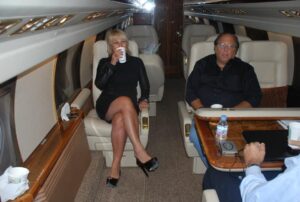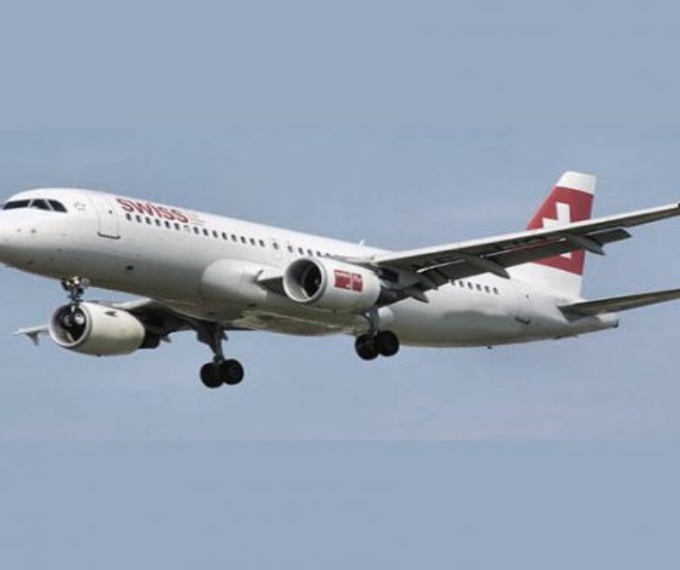
On 2 September 1998, Swissair Flight 111 departed New York, United States of America, at 20:18, on a scheduled flight to Geneva, Switzerland, with 215 passengers and 14 crew members on board. Some 53 minutes later, the flight crew smelled an abnormal odour in the cockpit. Their attention was then drawn to an unspecified area behind and above them, and they began to investigate the source. Whatever they saw initially was shortly, thereafter, no longer perceived to be visible.

They agreed that the origin of the anomaly was the air conditioning system. When they assessed that what they had seen, or were now seeing, was definitely smoke, they decided to divert. They initially began a turn towards Boston; however, when air traffic services mentioned Halifax, Nova Scotia, as an alternative airport, they changed the destination to the Halifax International Airport. While the flight crew was preparing for the landing in Halifax, they were unaware that a fire was spreading above the ceiling in the front area of the aircraft.
About 13 minutes after the abnormal odour was detected, the aircraft’s flight data recorder began to record a rapid succession of aircraft systems-related failures. The flight crew declared an emergency and indicated a need to land immediately. About one minute later, radio communications and secondary radar contact with the aircraft were lost, and the flight recorders stopped functioning. Approximately five minutes and ninety seconds later, the aircraft crashed into the ocean about five nautical miles southwest of Peggy’s Cove, Nova Scotia, Canada. The aircraft was destroyed and there were no survivors.
All recorded communications between SR 111 and the various air traffic control (ATC) units involved with the flight were of good technical quality; that is, all of the recording equipment functioned normally and the sound quality was up to the normal standard. All ground-based radio communications facilities related to the SR 111 flight were serviceable.
Boston Air Route Traffic Control Center (ARTCC) experienced a 13-minute communications gap with SR 111, starting at 0033 and ending at about 0046. About 15 minutes after take-off, a 13-minute gap in radio communications occurred between SR 111 and Boston ARTCC. The last communication from SR 111 prior to the gap occurred at 0033:12 when the captain acknowledged a radio frequency assignment change from Boston ARTCC (124.52 MHz to 128.75 MHz). Nine seconds later (0033:21), the FDR recorded a VHF 1 microphone keying event that would be consistent with the pilots attempting to contact Boston ARTCC. No transmission from SR 111 was heard on frequency 128.75 MHz or on any other recorded ATS frequency.
The SR 111 FDR recorded 11 microphone keying events by SR 111 during the 13-minute gap: 9 on VHF 1 and 2 on VHF 2. During this time, Boston ARTCC attempted to contact SR 111 four times on the assigned frequency of 128.75 MHz, three times on the previous frequency of 124.52 MHz, and at least once on the aviation emergency frequency of 121.5 MHz. None of the 11 keying events from the aircraft coincided with the times of the transmissions from Boston ARTCC, indicating that the SR 111 crew was not likely receiving the ATS radio calls. At 0046:27, SR 111 called Boston ARTCC using VHF 1 on 134.95 MHz, a frequency that had not been assigned to the flight. This transmission was recorded on the ATS tape; however, the Boston ARTCC controller did not comprehend the call that was made on an unassigned frequency and did not immediately respond to this first SR 111 call.
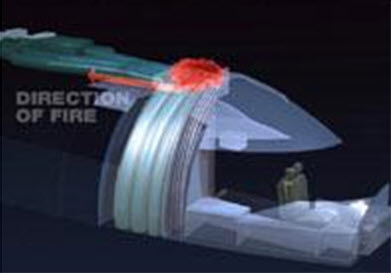
The FDR indicates that at 0047:02, SR 111 attempted another brief call on VHF 1 on an unknown frequency. At 0047:03, INMARSAT logs show a downlink from SR 111 indicating that VHF 3 data communications were lost. This downlink would be consistent with VHF 3 being switched by the pilots from data to voice mode. At 0047:15, SR 111 again called Boston ARTCC using VHF 1 on 134.95 MHz. Communications with SR 111 was restored when Boston ARTCC heard and acknowledged this transmission and instructed SR 111 to switch to the appropriate frequency for the area control sector they were in (133.45 MHz). Two-way communications were then restored, and the controller established that the SR 111 crew could hear ATS clearly.
There is no record of either the pilots or the controllers at Boston ARTCC making any further comments about the gap in communications. There were no reports of communications difficulties between ATS and any other aircraft in the area. No technical anomalies were recorded on the FDR during the 13-minute gap, and no plausible technical failures were determined during the investigation.
It should be noted that FDRs record only a small percentage of the total electrical and systems activity that occurs on an aircraft. Radio communication gaps periodically occur when pilots inadvertently select an incorrect radio frequency when reassigned a new frequency. It is unknown whether this occurred in this instance; however, no other explanation was found. Other than this anomaly, no communications interruptions or discrepancies were reported by ATS or by any other aircraft along the route flown by SR 111 during the time of the flight.
The search and rescue response to the event was immediate, and included resources from the Canadian Forces (CF) (Department of National Defence (DND)), Canadian Coast Guard (Department of Fisheries and Oceans), the Royal Canadian Mounted Police (RCMP) (Department of the Solicitor General of Canada), and numerous private individuals in boats from the local area. An exclusion zone was put in place to protect the site and to provide security during recovery operations. The exclusion zone was removed on 1 November 1999. Until that time, there was continuous security in place, and no known breaches of security occurred. Recovery and sorting of the wreckage took approximately 15 months to complete.
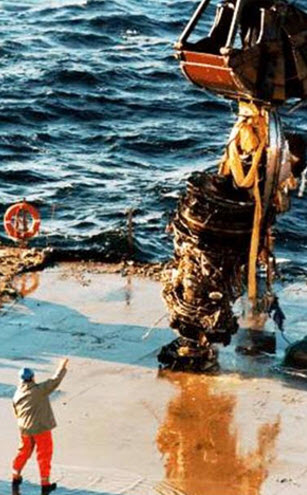
The wreckage site was located when the submarine HMCS Okanagan homed in on the underwater locator beacons (ULB) from the flight recorders. Various ship-borne underwater imaging technologies, divers, and video cameras on remotely operated vehicles (ROV), provided information about the wreckage condition and dispersion. The main debris field measured approximately 125 by 95 m (411 by 312 feet). The water depth was about 55 m (180 feet).
The focus of the initial recovery phase was on finding and recovering human remains, and on locating the CVR and the FDR. Extensive surveillance of the wreckage field and the surrounding area was completed to assess the various recovery options. Floating wreckage was scattered by wind and water currents, but no major piece of wreckage was found outside the confines of the irregularly shaped, single debris field on the seabed. Wreckage recovery operations yielded over 126 554 kg (279,000 lb) of aircraft material, which represented approximately 98 per cent of the structural weight of the aircraft. Over 18 144 kg (40,000 lb) of cargo was also recovered. The official cause of the ‘crash’ was deemed as follows:
- Aircraft certification standards for material flammability were inadequate in that they allowed the use of materials that could be ignited and sustain or propagate fire. Consequently, flammable material propagated a fire that started above the ceiling on the right side of the cockpit near the cockpit rear wall. The fire spread and intensified rapidly to the extent that it degraded aircraft systems and the cockpit environment, and ultimately led to the loss of control of the aircraft.
- Metallized polyethylene terephthalate (MPET)–type cover material on the thermal acoustic insulation blankets used in the aircraft was flammable. The cover material was most likely the first material to ignite and constituted the largest portion of the combustible materials that contributed to the propagation and intensity of the fire.
- Once ignited, other types of thermal acoustic insulation cover materials exhibit flame propagation characteristics similar to MPET-covered insulation blankets and do not meet the proposed revised flammability test criteria. Metallized polyvinyl fluoride–type cover material was installed in HB-IWF and was involved in the in-flight fire.
- Silicone elastomeric end caps, hook-and-loop fasteners, foams, adhesives, and thermal acoustic insulation splicing tapes contributed to the propagation and intensity of the fire.
- The type of circuit breakers (CB) used in the aircraft was similar to those in general aircraft use, and was not capable of protecting against all types of wire arcing events. The fire most likely started from a wire arcing event.
- A segment of in-flight entertainment network (IFEN) power supply unit cable (1-3791) exhibited a region of resolidified copper on one wire that was caused by an arcing event. This resolidified copper was determined to be located near manufacturing station 383, in the area where the fire most likely originated. This arc was likely associated with the fire initiation event; however, it could not be determined whether this arced wire was the lead event.
- There were no built-in smoke and fire detection and suppression devices in the area where the fire started and propagated, nor were they required by regulation. The lack of such devices delayed the identification of the existence of the fire and allowed the fire to propagate unchecked until it became uncontrollable.
- There was a reliance on sight and smell to detect and differentiate between odour or smoke from different potential sources. This reliance resulted in the misidentification of the initial odour and smoke as originating from an air conditioning source.
- There was no integrated in-flight firefighting plan in place for the accident aircraft, nor was such a plan required by regulation. Therefore, the aircraft crew did not have procedures or training directing them to aggressively attempt to locate and eliminate the source of the smoke, and to expedite their preparations for a possible emergency landing. In the absence of such a fire fighting plan they concentrated on preparing the aircraft for the diversion and landing.
- There is no requirement that a fire-induced failure be considered when completing the system safety analysis required for certification. The fire-related failure of silicone elastomeric end caps installed on air conditioning ducts resulted in the addition of a continuous supply of conditioned air that contributed to the propagation and intensity of the fire.
- The loss of primary flight displays and lack of outside visual references forced the pilots to be reliant on the standby instruments for at least some portion of the last minutes of the flight. In the deteriorating cockpit environment, the positioning and small size of these instruments would have made it difficult for the pilots to transition to their use, and to continue to maintain the proper spatial orientation of the aircraft.
The official figure for loss of life is strangely 229/228.
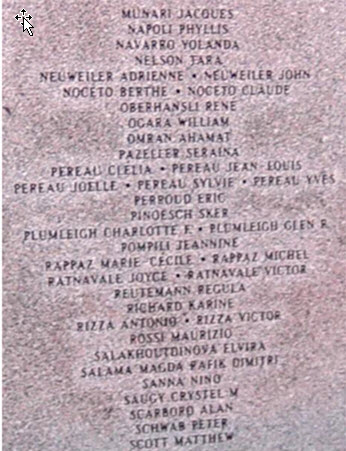
Certainly, 229 were on board of which 137 were US Citizens and 92 non-US.
One such person listed is N. Sanna and his nationality given as ‘Swiss’. There is listed only one person from ‘England’ a certain Norman Scouler and Stephanie Shaw from ‘Great Britain’. Notwithstanding, two citizens from the United Kingdom on board and despite their nationalities as being ‘English’ and ‘British’ the British Police have taken no action to date. Three members from the United Nations were on board as well as Jonathan Mann, the renowned American expert on AIDS who at one time headed the WHO fight against the disease, and his wife. The head of the FBI Louis Freeh stated that the first thing his agents were doing was to ‘examine the passenger list and ensure that any key evidence would be contained.’
It was an unusual statement that if properly considered at that time would have led to without doubt an enquiry. What was so important about the passenger list? What did the FBI know that was so important that it had to ‘contain’ any evidence it found? The Canadian Authorities and The White House within minutes of hearing of the crash both announced that the accident was not related to any terrorist act. Strange statements from both Governments shortly after hearing of the crash and with the aircraft and its victims still in the sea. The Canadian Government did, however, say it would liaise with the FBI regardless. On September 4th 1998 at 02.00 CET the airline released 213 names of passengers from 215. The reason given was that relatives had not been as yet informed. Whilst officially the number of killed is put at 229 the official record still states 228-229.
The plane crashed into the sea which to all intent and purposes was certainly a good factor as it immediately extinguished any fire but for those that are well expert in civil aviation accident investigations’ questions began to emerge. Why were ‘body parts’ being retrieved from the sea? A plane plunging into the water one would not normally expect a body to break and certainly no ‘body parts’ would be predominant. Not a single whole body was to be retrieved.
If one examines the crash of TWA 800 in similar circumstances bodies were retrieved still strapped to their seats.
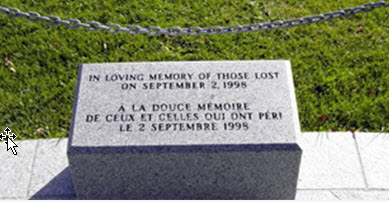
So, someone on that plane was a target and, to eliminate one, 227 had to be sacrificed. However, who was so important that merited the attention and the ultimate price? Who was responsible for such an act of mass murder? The TWA 800 incident over Long Island Sound, and the Swissair 111 incident in losing radio contact, in the same location were not the only strange events to happen in this area of Long Island Sound. There are two other incidents…..
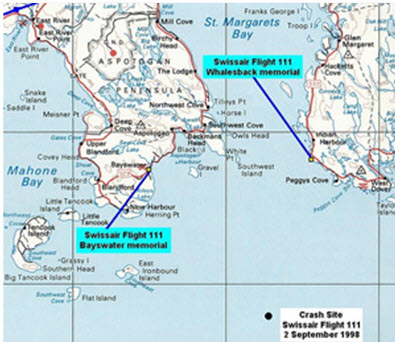
Three weeks to the day before TWA 800 was shot down in approximately the same location as the TWA 800 downing, and within hours of the Khobar Towers bombing in Saudi Arabia, the Coast Guard received a report of ‘three red flares’ launched 25 miles south of Shinnecock Inlet. An air and surface search was carried out which found nothing out of the ordinary. TWA Flight 848 (New York to Rome) blocked out at exactly 10:00 pm on June 26, 1996, and assuming normal handling, Flight 848 would have passed about 11 NM South of Shinnecock Inlet at 10:29 p.m. EDT.
TWA Flight 884 (New York to Tel Aviv) was scheduled to depart before FL 848 but blocked out late at 10:19 p.m. EDT. But what about the so-called nearby missile explosion? Could Swissair 111, like PIA 712 and TWA 884 in November 1996, have been the target of a missile that missed but did explode? Recall that the P3 flying in the vicinity of TWA 800 reported it had lost the use of several pieces of electrical equipment. Did it lose them because of the missile explosions that were occurring nearby and destroying TWA 800?
Could ‘something the size of a fingernail’ be a fragment from a missile that exploded too far from the aircraft to have caused significant damage? Could a fragment have penetrated the aircraft in the region where a major fire later ignited? Could an external explosion over Long Island Sound have temporarily knocked out the ability of Flight 111 to receive radio transmissions for a period of 13 minutes? What cockpit conversations were going on between the pilots at the start of the radio blackout? Did they know they were in a blackout? Did they hear anything strange at the beginning of the blackout period? Did they comment on any strange ‘turbulence’ at the beginning of the blackout period?
These are all questions that, notwithstanding the passage of time, no answer has been at all forthcoming. The answer, however, remains within the passenger list and what would be known as the triumvirate coup.
Nino Leonardo Sanna was one of the passengers killed as a result of the accident. A man of many parts, Nino Sanna was divorced with three children and with what he called ‘business interests worldwide’ but had certainly been subject to a number of criminal investigations by the Italian Authorities. At one time he travelled under a ‘blue’ United Nations Passport but more often his passport was issued by the Italian Authorities.
He spoke a number of languages, French and Spanish perfectly and some English.
What was he doing in New York? He had been in China and in Cyprus for a while and was a friend of the Cypriot Tycoon Asil Nadir and had been a guest of Nadir in N.Cyprus for some time. Was he hiding there, that is a question that no one has bothered to uncover?

Nino Leonardo Sanna (L) and Giovanni Di Stefano (R)
Al-Saud Bandar, 45 was also on board. He was related to the Saudi Ambassador to the United States, one of the richest men in the world. He had participated in a number of operations with the CIA, including, the Iran-Contra affair, drugs from the Golden Triangle, and more importantly, the sale of chemical weapons by the United States to Iraq. Bandar Al Saud and Nino Leonardo Sanna would be the targets by a man who made a habit of taking no prisoners.
In 1996 Osama Bin Laden declared ‘jihad’ against the Saudi Royal Family and the foreign presence in what was his country. In December of that year Bin Laden suffered acute poisoning which he firmly placed at the door of Saudi Prince Salman bin Abdul-Aziz. It would be his ultimate rehearsal of what was to come only three years later. Two citizens from Iran were on the flight Elahah Mehrarabansamit, and Mahmood Diba who was also a US citizen. Also, on-board was Zhora Froghi from Afghanistan. Did they play any part in the downing of Swissair 111?
In 1998 smoking was banned by the US on domestic flights, but it was not until 2000 that it was banned on all US carriers. It was not banned on Swissair Flight 111. Did any of the passengers deliberately set fire to the aircraft and, if so, it would have been those on the seats at the front of the aircraft. The two Iranians, and the Afghan, and the Saudi Citizen were in the front of the aircraft. Nino Leonardo Sanna was an avid smoker. It was a habit he simply could not shake.
After Cyprus and Turkey, he went to China where he remained and met a young Chinese girl. It was there that he entered the trade of selling arms. After a few trades he expanded but in his nature was always the idea of ‘having one over’ on whoever he could. He succeeded holding a party for over 200 guests at the Villa d’Este in Como, near George Clooney’s retreat. He succeeded in even double-dealing Asil Nadir by taking temporary control of the Kibris Bank.
In China though, the stakes were much higher. He was at the highest point in his life and boasting friends including the exiled King of Italy, and the Knights of Malta, he became a true big-time dealer, although, he never quite knew who he was dealing with. One of the shipments of arms he dealt in was for Afghanistan and in the usual and typical Nino Sanna way, he had to get an advantage that was not built in the contract. This time what he did not know was that he was selling arms from China to Osama Bin Laden. It would ultimately be his undoing and that of 227 others. But would Nino Sanna outwit even the most highly intelligent and best-connected then would-be terrorist in the world? Was Nino Sanna actually on board?
When the arms shipment for $6 million was not fully fulfilled, it roused the interest of Osama Bin Laden. He could not quite understand if the man that had tricked him was to be hired or to be liquidated. Ultimately, he chose the second but Nino Sanna was no ordinary shyster. For years he had worked for the CIA and the Italian Military Intelligence SISDE. When Bin Laden understood that from the arms shipment over one-third of the merchandise of death was missing, his first port of call was Nino Sanna. It is said he even thought it was a mistake.
Discussions between intermediaries in China and Nino Sanna reached the agreement that Sanna would go to New York, see his family, and procure half of the money to be reimbursed and one-sixth of the shipment he would add to the ‘next order.’
It was a smart move on the part of Sanna, as it ensured a further transaction with Bin Laden and an ever-ready Chinese Arms Industry ready to supply to anyone who would pay. But Bin Laden was one step ahead. An attempt to exterminate Sanna in New York on the 31 August 1998 failed. Bin Laden had a plan for the United States and he would test this plan on Nino Sanna’s return journey to Switzerland. But Nino Sanna had intelligence and Bin Laden was not, and could not, ever have been aware of such. Although Bin Laden had infiltrated the CIA, MI6 and two other Security Agencies, he was not able to engage any SISDE agents. It seemed the Italians were not, in this case, capable of corruption. But they were capable of obtaining information.
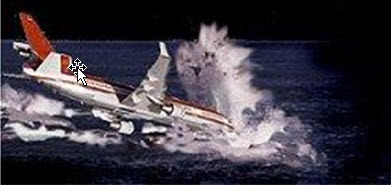
When SISDE informed Sanna that he was a target and that the possibilities of an attack did not, and could not, exclude whilst on any form of transport, Nino Sanna at 19.30 at New York Airport boarded the Swissair Flight 111 and then simply went back out without even being noticed. It is why the passenger list of those perished reads 228/229.
Bin Laden wanted Al Bander and Sanna in one go and it would be his dummy run to what was to come three years later. By smoking in the cabin and in the toilet of the front of the aircraft the captain smelt smoke. But the cause was a bomb on board the plane and it hit the water. All the elements are those of an explosion that caused the ditching in the sea, not a fire. Bin Laden got one out of two but, as for Nino Sanna, he was the one that got away whilst 228 others paid the price.
As an aftermath, or afterthought, shortly after the crash, London City lawyers Clyde & Co, acting for Lloyds Insurers, tried to salvage what was considered to be £150 million in gold, jewels, diamonds, and banknotes, on the sea-floor bed. It was to be expected that the families of the bereaved condemned as ‘deplorable’ such an operation. The lawyers insisted it was only a way of fending off other would-be salvage firms to try and recoup the treasure from the depth of 200 ft. on the sea bed. Navy divers from USS Grapple assisted in the salvage operation, yet another unusual factor.
The diamonds had been packed into a stainless-steel tube, which may have disintegrated on impact or been driven deep into the seabed, according to investigators. Gold and banknotes were stored in shockproof safes. They included a consignment of millions of dollars in US notes being transferred from an American bank to a branch in Switzerland. The original recovery operation, which included navy divers, draggers and a giant vacuum dredging ship, recovered millions of pieces of wreckage from the sea bottom, but neither diamonds nor other valuable cargo. What happened to those diamonds and valuables? Where they in fact ever placed on board or did Bin Laden penetrate also the security at New York Airport and steal the cargo, thus, financing further the Jihad against all those that crossed him?
Most of the bodies and many belongings on board the New York – Geneva flight remain missing after salvage teams were forced to give up their search weeks after the disaster.
Only some 60 bodies were ever recovered – Nino Sanna was not one of them.
Bin Laden met his fate on 2 May 2011 by a bullet from a US Special Forces Operative, who by a strange coincidence is related to one of the victims on board Swissair Flight 111.
We publish a photo of Nino Leonardo Sanna taken 10 October 2011 after the TWA tragedy. Where is he now? Will be the subject of a major documentary by Giovanni Di Stefano, coming soon!
GDS
© giovannidistefano2012 – All Rights Reserved
FIRST PUBLISHED 27 JUNE 2012

NB: Some images retrieved from Google, will remove at owner’s request.

